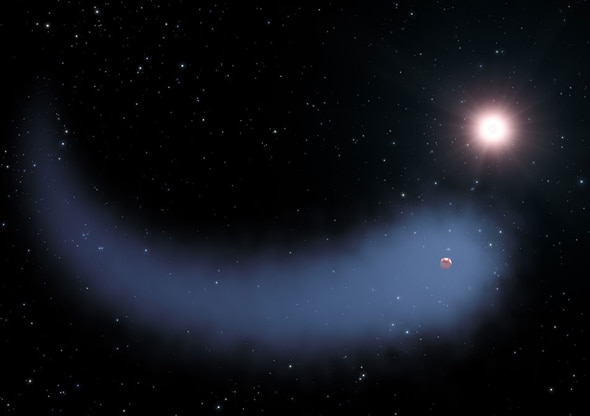Create a free profile to get unlimited access to exclusive videos, sweepstakes, and more!
A Star Boils Away Its Own Planet, Turning It Into a Megacomet

Hey, remember last week when I wrote about a Neptune-sized planet (called GJ 436b) that orbits a nearby star, and how it may have an atmosphere that’s almost entirely helium? That’s really weird, since the bigger planets in our solar system have predominantly hydrogen atmospheres. We’ve got nothing like a helium-rich planet in our solar system.
I wrote that the planet seemed to have no methane in its atmosphere as it should; that could be explained by a lack of hydrogen, needed to make methane. Astronomers were guessing that the planet orbits so closely to its star that the lightweight hydrogen would get blown away by the star, and the planet’s gravity is too weak to hold onto it. Helium is heavier and the planet can hold on to it better.
But hang on. It takes a long, long time to strip a planet of hydrogen. Billions of years! So, if what these astronomers were supposing is true, maybe, just maybe, GJ 436b is still losing hydrogen now.
Yeah, about that.
Astronomers using Hubble have just announced that they’ve detected a huge cloud of hydrogen around the planet, and the long, curving tail-like shape to the cloud indicates it’s being blown away from the planet by the star.
Huh.
When I got the press release for this, I did a double take. You don’t usually get observational proof of an idea so shortly after it’s first announced! But here it is.
The planet GJ 436b is called a warm Neptune because, at 23 times the mass of Earth, it’s closer to Neptune's mass than it is to Earth or Jupiter, and it orbits the star only a few million kilometers out. From our point of view it passes directly in front of the star, transits it, once per orbit. That’s how it was first discovered; once every 2.6 Earth days the starlight dims a bit as it’s blocked by the planet. The amount of visible light blocked is small, less than 1%, but measurable.
The astronomers observed the star, a red dwarf about 30 light years from Earth, before, during, and after such a transit. They used the Space Telescope Imaging Spectrograph (a camera I helped calibrate!) to observe the star in the ultraviolet, where hydrogen atoms just love to absorb light. What they found is that the amount of UV light they saw from the star dropped precipitously, by over 50%, starting about two hours before the transit, and lasting for three hours after.
Not only that, they could measure the velocity of the hydrogen atoms as they move around the star. Using 3D modeling, the best fit to what they see is a huge cloud of hydrogen around the planet, forming a comet-like tail sweeping out behind it. Here's a the video showing a depiction of the planet and cloud passing in front of the star. The graph below it shows how the UV light gets absorbed by the hydrogen over time.
Most likely what’s happening is that the lightweight hydrogen is very hot due to the planet being so close to the star. The atoms move so rapidly due to heat that they get flung far above the planet, where the light from the star can give them an additional push, freeing them from the planet’s gravity. That push isn’t terribly strong, so they don’t just fly off and away, but instead form a puffy cloud around the planet, and a long tail of material trailing the planet as it orbits. That’s much the same as how comets form long curving tails as they orbit the Sun, too. Anyway, that’s why they see a dip in UV before the planet transits (that’s from the puffy cloud) and for many hours after (that’s the tail blocking the light).
The image at the top of this post gives you an idea of what this looks like. The star is boiling away the planet! Well, part of it, at least. Calculating the amount of hydrogen they see, and how fast it’s leaving GJ 436b, it looks like it would take many billions of years for the planet to lose all its hydrogen (though it’s possible the loss rate was higher in the past). But still, the planet is already billions of years old, so this method has clearly caused a severe depletion of hydrogen, explaining the lack of methane in its atmosphere, too.
I love it when a plan comes together.
All in all, this makes me smile. What’s not to love? A giant planet, skimming the surface of its star, its atmosphere being slowly torn away and trailing behind it, leaving behind mostly helium… which, as I mentioned in the earlier post, will make the planet oddly gray in color.
This is nothing at all like any planet we have here in our neighborhood. That’s so cool! The goal of science may be to learn as much as we can about the Universe, but the motivation for so many of us is the weird, the spectacular, the alien, the amazing.
This planet is all of those, and more.


























